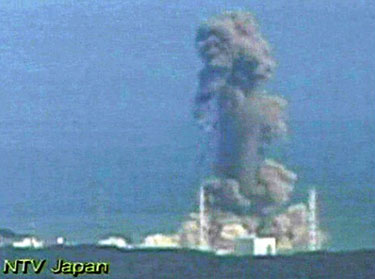The New York Times editorialized recently that
“Japan was facing the full meltdown of crippled reactors at a nuclear power station — with unknown and potentially catastrophic consequences.”
In fact, the potential consequences of the meltdown are fairly well-known. And paradoxically, they are not at all what people imagine them to be.
While the nuclear accident at Fukushima is chilling, tragic and certainly was preventable (the nuclear plant seawall barrier was only 9 feet high – the tsunami 30 feet), the potential loss of life from a nuclear meltdown still pales in comparison to the devastating effects of the tsunami. And even in the most dire possible outcomes of total meltdown, the effects of the nuclear accident, even accumulated over decades, will, as far as can be determined, still cause far less loss of life than the tsunami has already caused.
How could this be true? Could not the radioactive fallout of a meltdown kill all those in its path and irradiate the surrounding area for thousands of years?
The answer, quite simply is: judging by past history, no. We already know what happens to populations when a nuclear reactors melts down. In 1986 Chernobyl nuclear plant experienced a series of explosions, fires and a catastrophic meltdown of the reactor, with up to half of the graphite burning away, spewing radioactive iodine, cesium and strontium into the surrounding population centers. The huge radioactive emissions continued for two full weeks. Since the reactor had no containment structure around it (unlike those at Fukushima), the fires simply dumped all radioactivity and poisonous elements into the air. We will examine exactly what then happened shortly.
Many in the media today mention the danger of emissions of radioactive Uranium235 which has a half-life of 700 millions of years (half of the radioactivity decays in that time). However the radiation from uranium is far less damaging to humans during exposure, but ingestion (or breathing) may be damaging. Likewise for radioactive plutonium, but the evidence is less definite. Regardless, both uranium and plutonium emit alpha particles which are less damaging to humans and both are mostly broken down into other elements before being emitted in meltdowns. Uranium and plutonium are most likely to melt down through the structure and stay on site, unlike the other elements that are released into the air. Most of the radioactive airborne emissions from a meltdown are iodine, and lesser amounts of cesium and strontium. These are the three which should be the focus of impact of meltdowns on humans.
So what is the possible outcome of these three emissions on a population?
As mentioned earlier, Iodine is a risk and is by far the most prevalent of the radioactive emissions from meltdown. However, the impact on death rate of those exposed is very low. Radioactive iodine (Iodine131) can replace non-radioactive iodine Iodine128 which humans use in thyroid cells and by replacing non-radioactive with radioactive iodine, can produce thyroid cancer after years of exposure. However, thyroid cancer has a survival rate of well over 95%, so deaths are relatively low from radioactive iodine. Further, the half-life of Iodine131 is only eight days, so the total impact on a population is less than for the other emissions. Paradoxically too, high exposure of Iodine131 is less dangerous than low exposure – high exposure will kill the thyroid cells, rather than cause malignancy. The total deaths from Iodine131 attributed (so far) to Chernobyl is 10. Yes, 10 deaths in total.
Cesium137 and Strontium90, the other two major emissions from a meltdown, have more serious public health impact, both displacing normal minerals in bones (calcium) and tissue (potassium). Further the half-life of both elements is 30 years, so they can last a lifetime in the body if not expelled, and cause cancer.
Nonetheless, if one believe the IAEA, the worst disaster ever with the worst cleanup safety procedures ever (that is, none) – in Chernobyl – caused 37 immediate deaths from firefighter exposure, 10 deaths from iodine exposure over the years, and perhaps 4,000 premature deaths from cancer over the lifetime of the entire population from Iodine, Cesium and Strontium exposure. This expected death toll is after total meltdown, evaporation of reactor into the air (with no containment vessel), and the (criminal) employment of one-half million people in vicinity after the accident to clean up the fallout. And today, all of the iodine, Cesium and Strontium in the outside of the 30-km Chernobyl area is at safe levels.
The expected surplus death rate for those exposed in 1986 is on the same order of the surplus deaths expected among the same population from smoking for perhaps an additional week in their lives – a very important one, but not of the magnitude that the media has portrayed. Attempts to estimate additional premature deaths from extremely low exposures far from the original site are difficult to impossible due to these exposures being lower than normal background radiation already naturally existing in the environment. So 4,000 premature deaths is the most reliable estimate available.
Compare Chernobyl’s worst-case of excess deaths from a total meltdown with no containment vessel to the immediate effects of the Japanese tsunami – tens of thousands of immediate deaths. This puts the entire potential Japanese meltdown in a more realistic, if less sensational, perspective.
